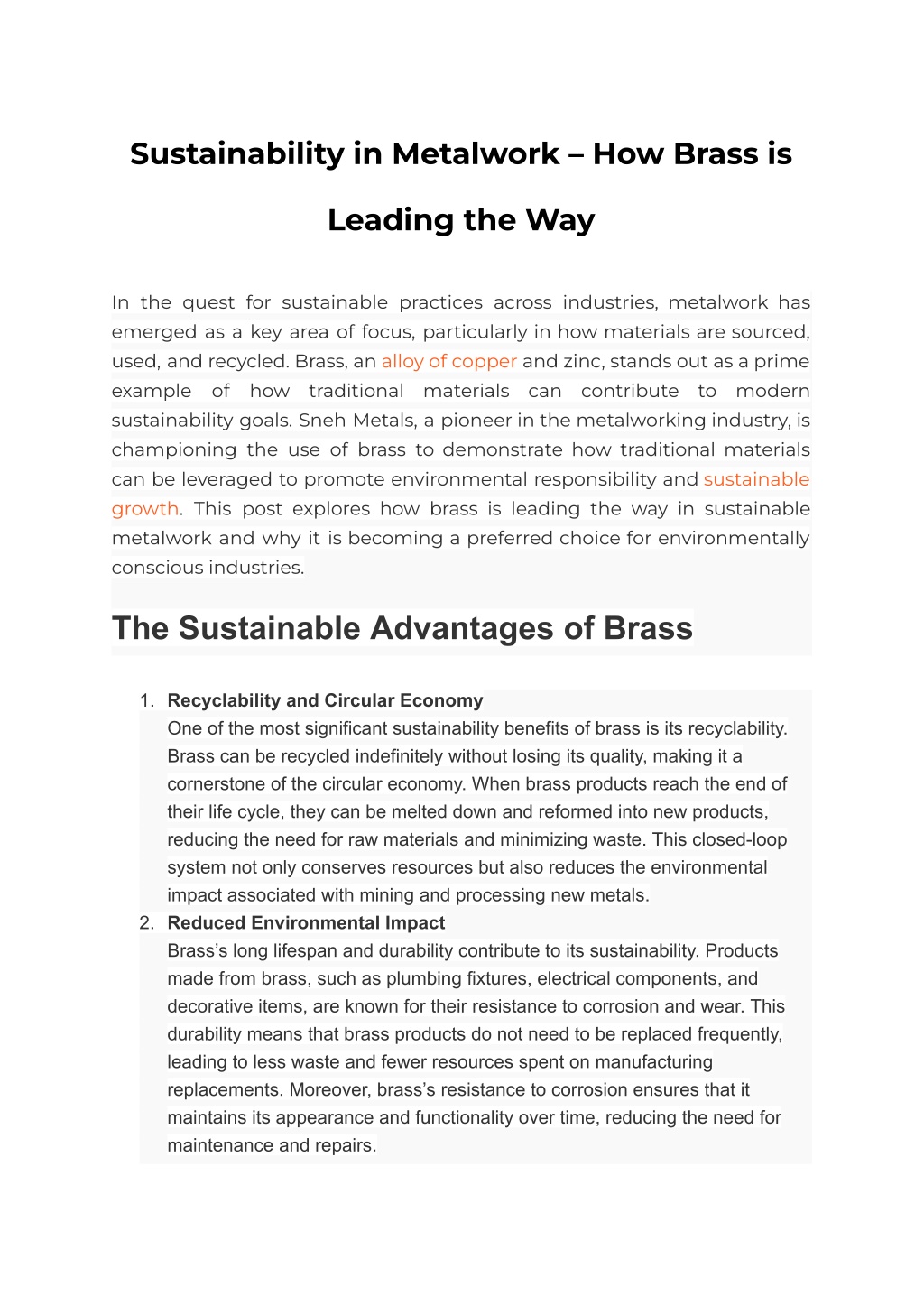
Sustainability in Metalwork – How Brass is Leading the Way
This post explores how brass is leading the way in sustainable metalwork and why it is becoming a preferred choice for environmentally conscious industries.
- brass extrusion rod
- brass parts
- copper bars
- copper alloy ingots
- brass square bar
- square brass rod
- brass rod
- brass hollow rods
- brass flats
- brass ingot
- brass billet
- metal ingots
- brass bar
- brass round bar
- brass round rod
- hexagonal brass rod
- brass fitting
- brass scrap
- brass component
- brass products
Download Presentation

Please find below an Image/Link to download the presentation.
The content on the website is provided AS IS for your information and personal use only. It may not be sold, licensed, or shared on other websites without obtaining consent from the author. Download presentation by click this link. If you encounter any issues during the download, it is possible that the publisher has removed the file from their server.
E N D
Presentation Transcript
Sustainability in Metalwork How Brass is Leading the Way In the quest for sustainable practices across industries, metalwork has emerged as a key area of focus, particularly in how materials are sourced, used, and recycled. Brass, an alloy of copper and zinc, stands out as a prime example of how traditional materials sustainability goals. Sneh Metals, a pioneer in the metalworking industry, is championing the use of brass to demonstrate how traditional materials can be leveraged to promote environmental responsibility and sustainable growth. This post explores how brass is leading the way in sustainable metalwork and why it is becoming a preferred choice for environmentally conscious industries. can contribute to modern The Sustainable Advantages of Brass 1. Recyclability and Circular Economy One of the most significant sustainability benefits of brass is its recyclability. Brass can be recycled indefinitely without losing its quality, making it a cornerstone of the circular economy. When brass products reach the end of their life cycle, they can be melted down and reformed into new products, reducing the need for raw materials and minimizing waste. This closed-loop system not only conserves resources but also reduces the environmental impact associated with mining and processing new metals. 2. Reduced Environmental Impact Brass s long lifespan and durability contribute to its sustainability. Products made from brass, such as plumbing fixtures, electrical components, and decorative items, are known for their resistance to corrosion and wear. This durability means that brass products do not need to be replaced frequently, leading to less waste and fewer resources spent on manufacturing replacements. Moreover, brass s resistance to corrosion ensures that it maintains its appearance and functionality over time, reducing the need for maintenance and repairs.
3. Energy Efficiency in Production The production of brass ingots involves processes that are relatively energy-efficient compared to other metals. The melting and casting of brass require less energy than the extraction and refinement of some other metals, contributing to a lower carbon footprint. Additionally, advancements in production technologies and processes have further improved the energy efficiency of brass manufacturing, aligning with modern sustainability goals. 4. Contribution to Sustainable Design Brass s versatility and aesthetic appeal make it a popular choice in sustainable design. From architectural elements to consumer goods, brass is used in a variety of applications that emphasize both form and function. Its ability to be easily machined into precise shapes and its compatibility with various finishes allow designers to create products that are both visually appealing and environmentally responsible. By choosing brass, designers can enhance the sustainability of their products while also achieving high standards of quality and performance. The Development Role of Brass in Sustainable 1. Supporting Eco-Friendly Industries Brass is increasingly being used in industries that prioritize sustainability. For example, in the construction and architecture sectors, brass fittings and fixtures contribute to the longevity and environmental performance of buildings. In the renewable energy sector, brass components are used in wind turbines and solar panels, supporting the transition to clean energy sources. By integrating brass into these applications, industries can align their practices with broader sustainability objectives. 2. Encouraging Responsible Manufacturing The brass industry itself is also embracing sustainability through responsible manufacturing practices. Many brass producers are investing in technologies that reduce emissions, minimize waste, and conserve water. These efforts reflect a commitment to not only producing high-quality materials but also doing so in a manner that supports environmental stewardship. 3. Educating Consumers and Industry Professionals Raising awareness about the benefits of brass in sustainability is crucial for driving its adoption. By educating consumers and industry professionals about
the environmental advantages of brass, its role in sustainable design, and its contribution to the circular economy, we can encourage more responsible choices in metalwork and beyond. Conclusion Brass is not just a durable and versatile material; it is a leader in sustainable metalwork. Its recyclability, energy performance make it an exemplary choice for environmentally conscious applications. As industries and sustainability, brass will continue to play a vital role in shaping a more sustainable future. Embracing brass in metalwork is a step toward achieving broader environmental goals while benefiting from a material that stands the test of time. efficiency, and long-lasting consumers increasingly prioritize Sneh Metals exemplifies how the metalworking industry can embrace sustainable practices through the responsible use of brass. By focusing on recyclability, durability, energy efficiency, and innovation, Sneh Metals is paving the way for a greener future in metalwork. As the demand for eco-friendly solutions grows, brass s role in promoting sustainability will continue to be a crucial factor in shaping the industry s future.






















